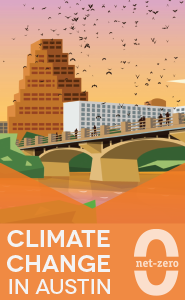Austin is addressing climate challenges through initiatives focused on community preparedness, resilient infrastructure, and sustainable solutions. By working together with partners and using data-driven strategies, we're adapting to changing conditions and building a stronger, more resilient future for all. Explore our efforts below.
One Austin: Our Resilience Framework for Action
This framework outlines Austin's key challenges, aspirations, and priorities, drawing from city plans and input from our Community Advisory Committee. It guides research and public engagement with City staff, local agencies, nonprofits, businesses, and elected officials.
Through collaboration, we aim to uplift existing initiatives and co-create actions that build resilience for individuals, neighborhoods, and our region.
- Read about One Austin - Our Resilience Framework for Action (PDF, 1,265 KB)
- Lea sobre el plan Un solo Austin - Nuestro Marco de Acción Para la Resiliencia (PDF, 1,201 KB)
UT-City CoLab
Austin faces increasingly frequent and intense extreme weather. To better prepare for the future, the City of Austin partnered with the University of Texas Jackson School of Geosciences to create the world’s first city-specific climate collaborative. The UT-City CoLab develops Austin-focused climate data, tools, and assessments. Explore recent resources created by the CoLab:
Austin Resilience Network
Led by the Homeland Security and Emergency Management Department, the Austin Resilience Network (ARN) connects City and community resources to help Austinites prepare for, respond to, and recover from community-wide shocks, stressors, and emergencies. As the next phase of Austin’s resilience efforts, the ARN creates a flexible, equity-focused model to enhance resilience across the city.
By fostering collaboration with community partners, the ARN expands on the Resilience Hubs pilot program, increasing capacity and adaptability to meet the needs of all neighborhoods to ensure our community can endure challenges and bounce back stronger.
Climate Resilience for City Operations
The Climate Resilience Action Plan for City Assets and Operations (PDF, 3.3 MB) guides how Austin’s City departments manage operations, assets, and long-term planning in response to climate change. It focuses on essential services and physical assets like energy, water, telecom infrastructure, roads, and community facilities, providing strategies for resilience and sustainability.
Heat Resilience and Mapping
Austin’s first Heat Resilience Playbook (PDF 5.5 MB) emphasizes strategic actions the City and partners are taking to support community preparedness, prioritize cooling investments in high-heat neighborhoods, and ensure our infrastructure is resilient.
The City hopes to raise residents' awareness of heat risks, develop a collaborative framework within the City and community to build heat resilience, and establish a coordinated implementation of heat resilience efforts in Austin.
Explore more heat-related resources:
- NASA Heat Map
- Heat Watch Data
- Urban Heat and Cool Space Design (PDF, 1 MB)
- Heat Awareness Tips
- Community Heat Report (2022-2023) (PDF, 294 KB)


